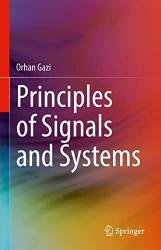Principles of Signals and Systems
- Добавил: literator
- Дата: 4-12-2022, 10:53
- Комментариев: 0
 Название: Principles of Signals and Systems
Название: Principles of Signals and SystemsАвтор: Orhan Gazi
Издательство: Springer
Год: 2023
Страниц: 376
Язык: английский
Формат: pdf (true)
Размер: 13.1 MB
The textbook presents basic concepts of signals and systems in a clear manner, based on the author's 15+ years of teaching the undergraduate course for engineering students. To attain full benefit from the content, readers should have a strong knowledge of calculus and be familiar with integration, differentiation, and summation operations. The book starts with an introduction to signals and systems and continues with coverage of basic signal functions and their manipulations; energy, power, convolution, and systems; Fourier analysis of continuous time signals and digital signals; Laplace transform; and Z transforms. Practical applications are included throughout. The book is also packed with solved examples, self-study exercises, and end of chapter problems.
A signal can be defined as a physical phenomenon that carries information. Examples of signals are human voice, electromagnetic waves, and sonar waves. Any quantity does not necessarily have to be in a waveform type to be considered as a signal. For example, Indians in ancient times used smoke to report any danger. The smoke used here is the signal carrier, and the shape of the smoke contains information. To give another example, let us say two persons are sitting in a room and one of these persons wants to describe an item to the other. For this, he only makes movements with his hands and tries to describe the item. We can accept the hands of the person as signal carriers and meaningful movements as signal. However, since movements containing meaning have to be with the carrier, in this case, we can accept the person’s hands and the movements of the hands containing meaning as signal. Even a blink event and a facial expression can be given as an example of a signal. Signals change over time, and some are defined over a period of time. In order to show the changes of signals over time, it is necessary to describe them with some mathematical functions. The mathematical function used describes the changes in the signal over time and becomes a kind of synonym for the signal.
In Chap. 1, general definitions of signals and systems are provided, and we try to motivate the reader to the subject. In Chap. 2, definitions of the basic signal functions used in the literature are laid out. In Chap. 3, energy and power of the signals are explained. In Chap. 4, we discuss the Fourier analysis of continuous-time signals, one of the main topics of the book. The topics before Chap. 4 can be considered as preparatory subjects to the main topics. Fourier analyses of discrete-time signals, which are digital versions of continuous-time signals, are covered in Chap. 5. Laplace and Z-transforms, which can be considered as the generalized versions of Fourier analyses of continuous-time and discrete-time signals, are explained in Chaps. 6 and 7. In Chap. 8, the practical applications illustrating the use of discrete Fourier transform are provided.
Скачать Principles of Signals and Systems
Внимание
Уважаемый посетитель, Вы зашли на сайт как незарегистрированный пользователь.
Мы рекомендуем Вам зарегистрироваться либо войти на сайт под своим именем.
Уважаемый посетитель, Вы зашли на сайт как незарегистрированный пользователь.
Мы рекомендуем Вам зарегистрироваться либо войти на сайт под своим именем.
Информация
Посетители, находящиеся в группе Гости, не могут оставлять комментарии к данной публикации.
Посетители, находящиеся в группе Гости, не могут оставлять комментарии к данной публикации.
